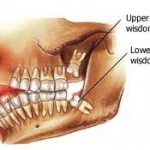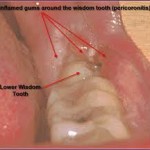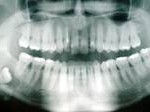What is a wisdom tooth?

A person’s dentition comprises of a set of 32 healthy teeth. There are three molar tooth on each quadrant situated furthest back in the mouth used for chewing food making it 36 in total. Wisdom tooth is an individual’s third molar. The third molars erupt behind the second molars. The eruption process takes place around 18-24 years of age hence the name but can also erupt at a later age or remain absent. Incidence of at least one impacted wisdom tooth is high. They are classified according to their alignment in the jaw as horizontal, vertical, mesioangular or distoangular. Early detection of wisdom tooth impaction can be done with an X-ray taken periodically to evaluate the position of the tooth. Even in absence of any problem, early removal is recommended to avoid further problems in future as the roots are not fully formed and bone is less dense. Healing time and recovery is delayed in older individuals. Your dentist will apply pressure around the gumline to determine is the tooth is coming in successfully.
Signs and symptoms of wisdom tooth eruption
Â
1. Tingling sensation in the cheeks when lying down on a pillow or resting your hand against your cheeks.
2. Talking and eating becomes difficult and chewing efficiency is decreased due to mouth ulcers.
3. Gums appear red, inflamed, painful and tender around the impacted wisdom tooth as they try to break through the gums.
4. Stiffness and difficulty in opening the jaws wide for dentist to check or even upon yawning. Difficulty in swallowing can also take place and sensitivity to cold drinks.
5. Intense pain of long-term leading to severe pulsating headaches and jaw ache. Pain may also come from pressure of the erupting wisdom tooth against other teeth.
6. Touching the area around the wisdom tooth with a finger feels sore. You may feel a bony prominence if the gums are obstructing otherwise you may not feel the underlying tooth at all if it is completely bony impacted.
7. Facial movements become difficult and mild discomfort present which can be cured by warm pressures. Severe discomfort requires medical intervention and surgical removal of the impacted tooth.
8. Proper dental care cannot be carried out successfully leading to tooth decay and bad breath. Some may also experience unpleasant taste in the mouth when biting down in the area.
9. Localized infection due to gum flap overlying the partially impacted tooth entrapping food particles and bacteria causing pain. Severe infection leads to pus formation around the gums.
10. Irritation as the tooth rubs against the side of the mouth which is very uncomfortable.

Pericoronitis
11. Fever and fatigue due to muscle spam in the jaw resulting from pericoronitis. Biting from the opposite side causes trauma to the overlying gum flap.
12. Wisdom tooth erupting at wrong angles cause facial swelling and pain around the throat as well. Swollen lymph nodes in the neck occasionally.
13. Radiating pain to the ear and wisdom tooth that has broken down causes intense toothache due to the inflammation of the dental pulp.
14. Crossbite from inclination of other teeth as the wisdom tooth puts on constant pressure.
  Â
Indications for wisdom tooth removal
1. Lack of space – jaw not large enough to accommodate the newly erupting teeth into functional position for eating and chewing. They come out crooked or slanted.
2. Pericoronitis – wisdom tooth only partially erupted allowing bacteria to invade through and cause infection surrounding the gum resulting in pain, swelling, jaw stiffness and bad breath.
3. Decay – poor access for brushing and cleaning due to its unfavourable position in the mouth.
4. Crowding and resorption of adjacent teeth – wisdom teeth that incline towards the second molars causes resorption and damages the nerves. Crowding due to constant pressure in the mouth. These teeth are more prone to plaque and debris entrapment.
5. Cyst forming around the surrounding teeth creating a blockade in the eruption pathway and damage the adjacent bone. If left untreated, tumor is most likely to form.

Cyst
Wisdom Tooth Treatment
Â
Toothache and soreness developing from an impacted wisdom tooth can range from mild to severe depending on the condition of the teeth and adjacent tissues. Mild pain and discomfort can be treated by rinsing mouth with a warm salt water mouthwash to ward off infection. Chewing a sugarless chewing gum on the affected side will help ease pain temporarily. Brush after every meal and keep the area clean to prevent bacterial contamination that aggravates the pain. If pain is more severe, visit the dentist. He or she will prescribe antibiotics and pain killers such as acetaminophen, aspirin or ibuprofen. When pain and inflammation becomes unbearable and if pericoronitis recurs, you may need a oral surgery to cut through the gums and remove the underlying impacted wisdom tooth.
Whenever there is a problem of this sort during the eruption of wisdom tooth, surgical removal of the tooth is advised by dentists. So basically wisdom tooth removal is the answer to take care of all problems that can crop up while a wisdom tooth is erupting. When the wisdom tooth cannot grow properly, due to lack of space at the back of the mouth there can be swelling, pain, infection and soreness on the gum. This can also cause infection to the teeth around that portion and the jaw can become stiff and swollen.
thank you, im aware of wisdom tooth extraction prior to experiencing any complications later on.